
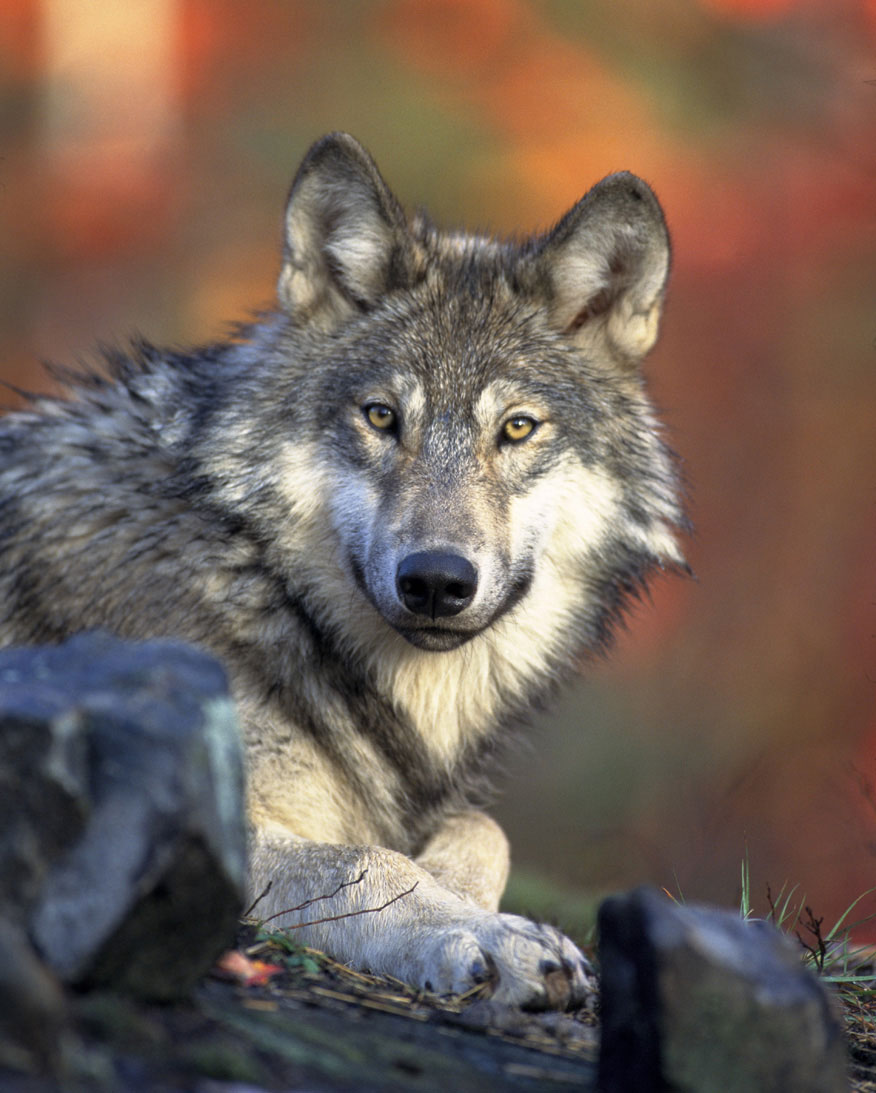
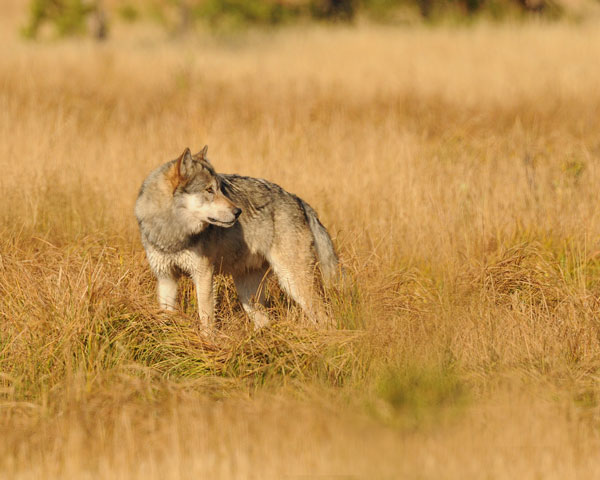
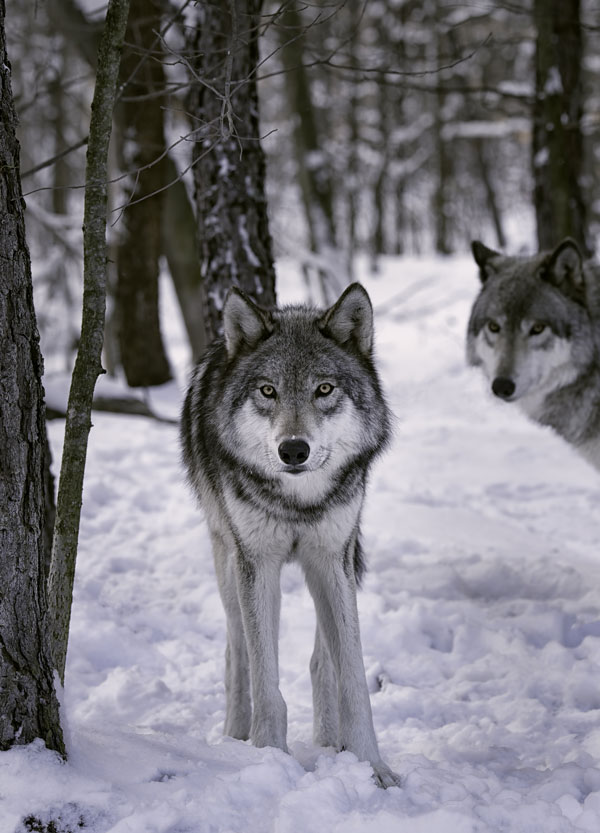
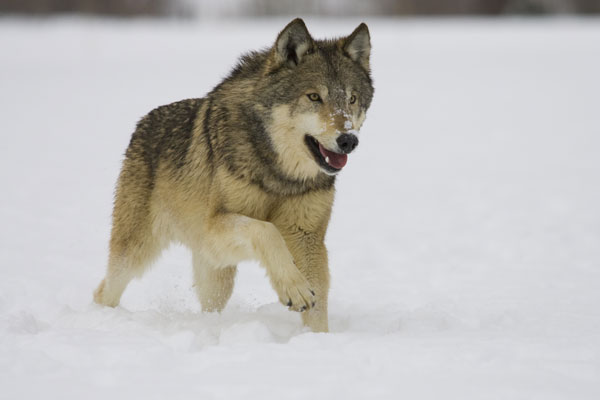
Montana Fish, Wildlife & Parks obtained full authority to manage wolves throughout the state upon the federal delisting of the Rocky Mountain gray wolf in May 2011. FWP is committed to ensuring the long-term survival of wolves while responsibly managing the population and addressing conflicts with livestock. FWP is also committed to involving hunters and trappers in the sustainable management of the species.
To report the harvest of a wolf during the hunting or trapping season, call the Harvest Reporting line at 1-877-FWP-WILD (1-877-397-9453).
To report a dead wolf or possible illegal activity, contact 1-800-TIP-MONT (1-800-847-6668) or a local game warden.
If you suspect a livestock loss due to wolf predation, you can request an investigation by contacting the USDA Wildlife Services: West District (406) 459-5943 or State Office (406) 657-6464.
Montana Fish, Wildlife & Parks is interested in public reports of wolf sightings and activity. To report wolves or wolf sign use our online Wolf Observation Report.
In 2025, FWP created and will implement a new conservation and management plan. The new plan includes updates to the original plan, which was released in 2003.
The foundations of the 2025 Wolf Plan are:
Recognize wolves as part of Montana’s wildlife heritage;
Approach wolf management similar to other wildlife species;
Manage wolf populations across the state with flexibility;
Address and resolve conflicts.
The new wolf plan shifts a key counting metric from the number of breeding pairs to the number of wolves representing at least 15 breeding pairs. The plan establishes that 450 wolves ensures 15 breeding pairs.
The Final Environmental Impact Statement (EIS) on statewide wolf management was released to the public on Feb. 21, 2025. This document analyzes two alternatives: a "no action" alternative and an alternative to "adopt the 2025 Montana Gray Wolf Conservation and Management Plan", which is the proposed alternative.
Issuing the final EIS is a key step in a process that started in December of 2023, when FWP originally released the draft EIS for two months of public comment. The draft EIS went out for an additional 30 days of public comment in February of this year to ensure partner agencies, affected county governments, and tribal agencies had a chance for review.
Executive Summary (PDF)
Final EIS (PDF)
FEIS Track Changes (PDF)
Montana Wolf Conservation and Management Plan 2003 (PDF)
Appendix 4: Sources of Written and Oral Comments on the Draft EIS, March/April/May 2003. Please email fwpwld@mt.gov to request a copy of this appendix
Montana Wolf Conservation and Management Planning Document (PDF)
Amended Record of Decision: Montana Gray Wolf Conservation and Management Plan (PDF
Summary of Montana's Wolf Relisting Response Efforts and Program Updates (PDF)
FWP is managing wolves in Montana in compliance with federal law and the state conservation and management plan.
Montana maintains sustainable hunting and trapping harvest opportunities for wolves through regulated seasons.
The wolf (Canis lupus) is the largest wild member of the dog family Canidae.
Wolves are highly social animals that live in groups, called packs. The average wolf pack in Montana has 6 to 8 animals. Packs typically include a breeding pair, their offspring, and other non-breeding adults.
Wolves are capable of breeding at 2 to 3 years of age. On average, four to five pups are born in early spring.
Wolf packs occur primarily in western Montana, but wolves could be found anywhere in Montana. Gray wolves are built for travel with narrow bodies, long legs and large feet. Wolf packs live within territories, which they defend from other wolves. They can easily cover 10-20 miles in a day within their territory, which is approximately 150 square miles. In the Northern Rocky Mountains, lone dispersing wolves travel on average 60-70 miles, but have traveled as far as 600 miles in search of a mate or territory.
Wolves in Montana can be a light gray, dark gray, black or even white as they approach old age. Full grown wolves are about 2.5 feet tall and 6 feet long. An average male will weigh 80-110 pounds. Females are slightly smaller, usually 75-90 pounds.
Wolves are carnivores at the top of the ecological pyramid. They seek large, vulnerable ungulates, such as deer, elk, and moose, as well as smaller mammals, such as beavers, rodents, and hares.
Wolf tracks are about 5 inches long by about 4 inches wide, with 4 toes and claws in an oval shape. Wolf scat ranges from a half to one and half inches in diameter, but is usually greater than an inch.
Echinococcus Fact Sheet (PDF)
The gray wolf was extirpated from the western United States during the 1900s, primarily due to loss of habitat and conflicts with people.
Although wolf packs were eliminated from Montana by the 1930s, tracks, scat, and/or observations of large canid-like animals were either reported or those animals were killed up until the 1970s. Most are thought to have been dispersers from Canada and little to no successful breeding activity was evidenced or sustained consistently through time.
The U.S. Fish and Wildlife Service listed the northern Rocky Mountain gray wolf as endangered under the Endangered Species Act in 1973.
In 1980, the Northern Rocky Mountain Wolf Recovery Team completed a plan that would guide wolf recovery efforts for a future wolf population in the northern Rockies of Montana, Idaho, and Wyoming. The recovery plan was revised in 1987. The plan designated three recovery areas - Northwestern Montana, Central Idaho, and the Greater Yellowstone - each of which included some portion of Montana.
Wolves from Canada began to naturally colonize the Glacier National Park area in 1979, and the first wolf den in the western U.S. in over 50 years was documented there in 1986. The wolf population in northwest Montana grew as a result of natural reproduction and dispersal. By the end of 1994, there were about 48 wolves in and around Glacier National Park.
In 1995, three family groups (a total of 14 wolves) were captured near Alberta's Jasper National Park, transported to Yellowstone National Park, and placed in acclimation pens. Two of the females subsequently denned and produced nine pups in Montana.
Also in the winter of 1995, 15 wolves were reintroduced into the wilderness areas of central Idaho. These animals moved widely throughout central Idaho and beyond. Many of these wolves moved north, some to the upper Bitterroot Valley. In 1996, three packs produced 11 pups.
In the winter of 1996, 17 wolves were captured near Fort St. Johns, British Columbia, Canada and were again released into acclimation pens in Yellowstone National Park. Twenty wolves were released in central Idaho. These translocated wolves were the same subspecies that existed in the northern Rocky Mountains historically.
Wolves were not released within Montana, but wolf populations in Yellowstone National Park and central Idaho grew rapidly and soon became a source for dispersers to Montana. New packs formed outside the earliest core wolf areas and overall wolf distribution expanded. Wolf dispersal has been documented between and among all three federal recovery areas and the states comprising the northern Rockies.
By the end of 2002, the northern Rockies wolf population met the biological recovery criteria of at least 30 breeding pairs in the northern Rockies for three years in a row. By the end of 2004, there was an estimated 835 wolves and 66 breeding pairs in the tri-state area. In Montana, there were about 153 wolves in 15 breeding pairs at that time.
Wolf populations in the Northern Rocky Mountains continued to expand and reached recovery goals. With the exception of Wyoming, they were delisted in 2011, giving management authority to the states. The five-year federal oversight period for Idaho and Montana ended in 2015 and wolf populations remained well above minimum federal management objectives of 15 breeding pairs and 150 wolves in each state.
While Montana has full authority to manage wolves in the state, federal regulations continue to guide management practices. To remain in compliance with federal law, FWP’s conservation and management program aims to maintain the overall population high enough to prevent its reclassification as "threatened" or "endangered" under the Endangered Species Act.
In 2003, FWP created and implemented its first Gray Wolf Conservation and Management Plan. Since that plan was implemented the wolf population has recovered and remained stable, and new research and management tools have become available.
In 2025, FWP will implement a new plan. The 2025 plan was built around the 2003 plan and addresses recent research regarding monitoring methods and management strategies and the changes in population status and harvest structure.
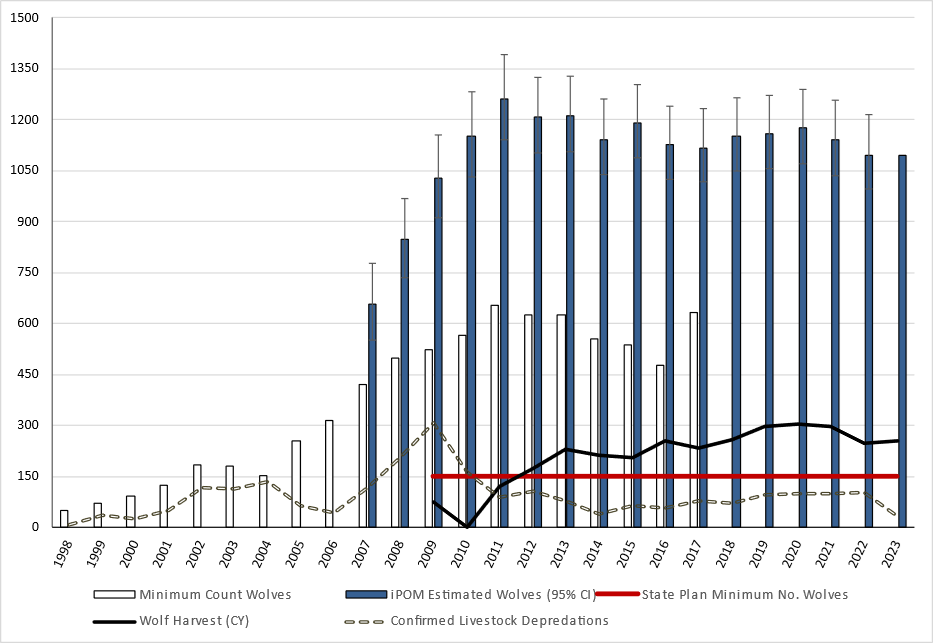
Integrated Patch Occupancy Modeling (iPOM) estimated number of wolves in Montana (including 95% confidence intervals) and verified minimum number of wolves residing in Montana in relation to state wolf plan requirements along with trends in wolf harvest and confirmed livestock losses due to wolves, 1998 – 2023.
Gray wolves are classified as a "Species in Need of Management" in the state. Montana maintains sustainable hunting and trapping opportunities for wolves that follow the commitments outlined in the state's conservation and management plan.
Before setting a wolf trap in Montana, a person must successfully complete either a Montana FWP or Idaho offered trapper education and certification course.
The Montana wolf trapper education and certification courses are free and open to individuals age 11 and older.
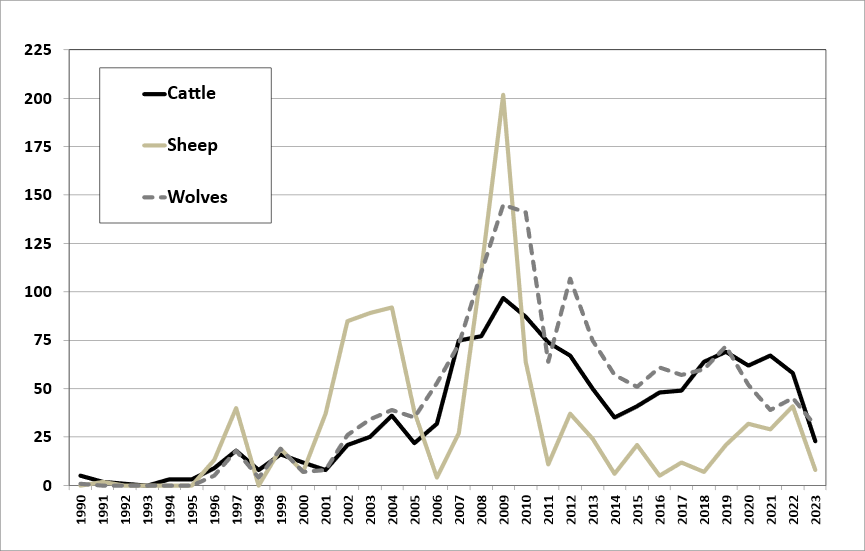
Number of cattle and sheep killed by wolves and number of wolves removed through agency control and legal depredation-related take by private citizens, 2000-2023.
Landowners or their agents may take up to 100 wolves a year that potentially threaten livestock, domestic dogs or human safety (MCA 87-1-901).
The quota will be examined in four 25-wolf increments. The Montana Fish & Wildlife Commission must approve the next increment toward the 100-wolf quota.
To report the harvest of a wolf, call the Harvest Reporting line at 1-877-FWP-WILD (1-877-397-9453).
The Montana Livestock Loss Board was established by the legislature in 2007 to address economic losses due to wolf predation and to create incentives for producers to take proactive, preventative steps to decrease the risk of loss.
The Wildlife Services program in Montana helps citizens, organizations, industries, and Government agencies resolve conflicts with wildlife to protect agriculture, other property, and natural resources, and to safeguard human health and safety.
If you suspect a livestock loss due to wolf predation, you can request an investigation by contacting the USDA Wildlife Services: West District (406) 459-5943 or State Office (406) 657-6464.
More Information
Annual reports present information on the status, distribution, and management of wolves in Montana.
Reports are a cooperative effort by FWP, USDA Wildlife Services, Glacier National Park, Yellowstone National Park, Blackfeet Nation, and The Confederated Salish and Kootenai Tribes.
Wolf-Ungulate studies in the Greater Yellowstone Area
Wolf-Human Dimension Research
Increasing tolerance of wolves in Montana, United States (2012–2023) (PDF)
2023 Survey Results (PDF)
2017 Survey Results (PDF)
2012 Survey Results (PDF)
Population Monitoring
Integrating basic and applied research to estimate carnivore abundance (PDF)
Competition, prey, and mortalities influence gray wolf group size (PDF)
Evidence of economical territory selection in a cooperative carnivore (PDF)
Economical defence of resources structures territorial space use in cooperative carinvore (PDF)
Competition, prey, and mortalities influence gray wolf group size (PDF)
Other Reports
Wolf Harvest Management Strategy Evaluation: Annual Report 2024 (PDF)
Integrated Carnivore-Ungulate Management: A Case Study in West-Central Montana (PDF)
Wolf collars provide valuable information to wildlife managers and researchers.
FWP's wolf specialists work throughout the state monitoring the wolf population, investigating wolf reports and wolf depredations, working with landowners, and doing public outreach
To report the harvest of a wolf during the hunting or trapping season, call the Harvest Reporting line at 1-877-FWP-WILD (1-877-397-9453).
To report a dead wolf or possible illegal activity, contact 1-800-TIP-MONT (1-800-847-6668) or a local game warden.
If you suspect a livestock loss due to wolf predation, you can request an investigation by contacting the USDA Wildlife Services: West District (406) 459-5943 or State Office (406) 657-6464.
| Wendy Cole |
Wolf Management Specialist |
Kalispell | (406) 751-4586 | wendy.cole@mt.gov |
| Tyler Parks |
Wolf Management Specialist |
Missoula |
(406) 531-4454 |
tylerparks@mt.gov |
| Sarah Zielke | Wolf Management Specialist | Great Falls | (406) 750-4279 | szielke@mt.gov |
| Nathan Lance |
Wolf Management Specialist |
Butte | (406) 425-3355 | nlance@mt.gov |
| Vacant |
Wolf Management Specialist |
Bozeman |
|
|
| Molly Parks |
Carnivore Coordinator |
Missoula | (406) 542-5509 | |
| Brian Wakeling |
Wildlife Management Bureau Chief |
Helena | (406) 444-3940 |
| Dalin Tidwell | USDA WS State Director | Billings | (406) 657-6464 |
| Kraig Glazier | USDA WS West District Supervisor | Helena | (406) 458-0106 |
| Douglas Ekberg | USDA WS East District Supervisor | Billings | (406) 657-6464 |
